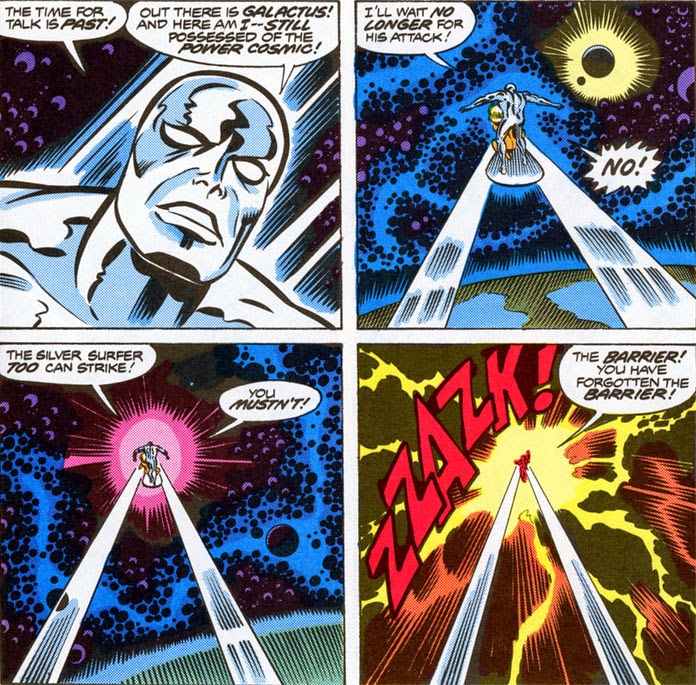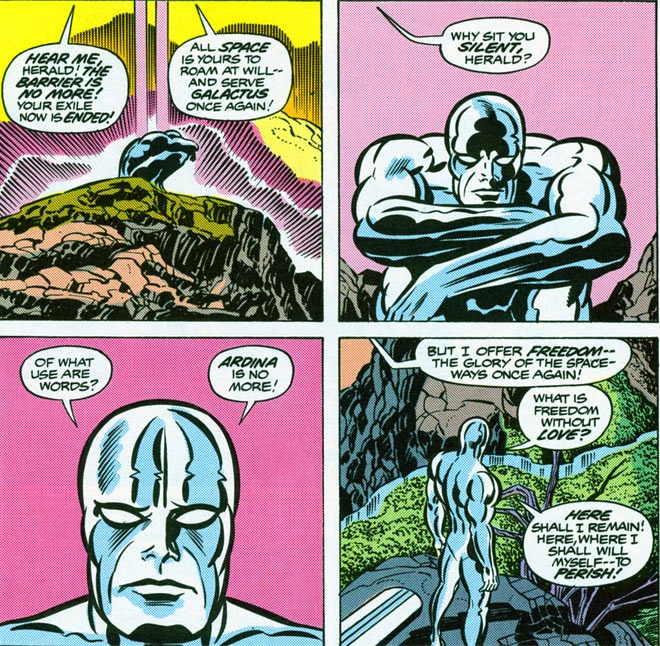 In Part One of our review of the 1978 Stan Lee/Jack Kirby graphic novel, The Silver Surfer, we saw the Surfer come to Earth to herald the arrival of his deadly master, Galactus, whose intention was to drain our planet of its life energy--only to find the Surfer had come to sympathize with the human race, and defend its right to continued existence by turning against Galactus. In retaliation, Galactus exiled the Surfer to Earth.
In Part One of our review of the 1978 Stan Lee/Jack Kirby graphic novel, The Silver Surfer, we saw the Surfer come to Earth to herald the arrival of his deadly master, Galactus, whose intention was to drain our planet of its life energy--only to find the Surfer had come to sympathize with the human race, and defend its right to continued existence by turning against Galactus. In retaliation, Galactus exiled the Surfer to Earth.Part Two saw Galactus craft a plan (with the help of his "Master of Guile") which resulted in the appearance of a mysterious and beautiful female, Ardina, who would insinuate herself into the Surfer's new life and attempt to entice him to return to his former master. And while the Surfer was indeed strongly drawn to Ardina, he would not be won over so easily; and so the two proceeded to weigh the merits and flaws of humanity, in order that each might succeed in swaying the other to their cause. While Galactus, monitoring from afar, found himself being given pause not only by the Surfer's willingness to fight for what he believed in, but by his curiosity as to how the situation between the Surfer and Ardina would play out--yet at the same time, making ready to move on the planet Earth if and when it became necessary.
Which now brings us to our third and final segment of our look at this classic tale, where we learn if humanity will prove worthy of the Surfer's sacrifice--or if the human race will drive away the one being who can save it from extinction.
The first and possibly most important stop for the Surfer and Ardina is the home of Sam and Beth Kemperer, a midwest couple who find themselves hosts to a most unnerving pair of visitors:
As might be apparent, Sam is highly skeptical of the possibility of these two being extra-terrestrials, though the circumstances of their arrival are sufficiently intriguing to warrant further scrutiny. But, when invited into the house, Ardina cannot resist the opportunity to demonstrate to the Surfer one of her points of contention--that he belongs in space with Galactus and herself, and nowhere else.
The fact that the Kemperers might be beginning to believe the origins of the Surfer seems of little importance to Ardina, as preoccupied as she is with changing the Surfer's priorities. However, with the Surfer indisposed, Ardina chooses to drive home her point to the humans, in a way that can leave little room for doubt of their credentials:
But, for the Surfer, his own well-being remains second to that of the world he has steadfastly pledged his protection to:
Despite what he's seen, though, Sam still fails to fully grasp the danger hanging over Earth like a cloud--and so the Surfer and Ardina depart, with Ardina thus far feeling confident about her chances of success.
Yet, impatient with this game he feels manipulated into, the Surfer terminates this exercise with Ardina and instead decides to take his argument directly to Galactus, while making use of all necessary force should a show of force be warranted. But Ardina quickly reminds him of the method Galactus has used to enforce the Surfer's exile, a warning which is conveyed too late:
While the Surfer plummets back to the Earth, Ardina is recalled by Galactus for what we might call a status report of the progress she's made with the Surfer. But Galactus finds that "progress" has instead been made on an unexpected front:
As Galactus begins an analysis of his "handiwork" in order to find out what has gone wrong, we discover the true nature of Ardina--that she's a genetic copy of Shalla Bal, the Surfer's mortal love from his home planet of Zenn-La, as a way to assure her of winning the Surfer's heart. Yet, despite his careful planning and technical proficiency in regards to Ardina, Galactus has reached one inescapable conclusion:
But even Galactus can't predict how this new development might affect the outcome of his dispute with the Surfer--and so he makes preparations to return Ardina to Earth. As for the Surfer, reviving in the eastern region of the planet after his collision with the barrier, it's here that Lee's story oddly doubles back on itself, with four additional pages of the Surfer experiencing the inhospitability of and irrational treatment by the humans he encounters:
The segment somehow seems misplaced, as if we should have instead read of such encounters just after the Surfer abandoned his pretense of human form and began exploring the planet--placement which would have given much greater impact to Ardina's initial argument about the worthlessness and utter insanity of mankind. With the Surfer's reckoning with Galactus imminent, these pages sap the momentum that's been building to this point, with material that feels redundant.
The only additional new material that feels as if it fits with the events of the story thus far is when the C.I.A. attempts to incapacitate the Surfer in a variation of the Sonic Shark incident in Fantastic Four--an attempt which makes sense to insert at this point, where the military has had enough time to assess the Surfer's presence on the planet and take appropriate measures toward making contact with or otherwise containing him:
Fortunately for the Surfer, it's here where Ardina rejoins him and takes him to an isolated area to recover his strength--as well as to deliver Galactus' final ultimatum.
But, in a surprising development for the Surfer, Ardina breaks with Galactus, and declares both her love and her loyalty to his former herald:
Ardina has time for a Helen Reddy moment, just before the retribution of Galactus makes its inevitable approach:
It's unclear why the Surfer doesn't attempt to just blow the thing to kingdom come; at any rate, he chooses instead to flee with Ardina, though Ardina seems resigned to her fate.
It's to the story's credit that Galactus looks on the matter with an air of practicality, despite his obvious regrets for his actions and tactics--perhaps he is, indeed, "beyond" the concepts of good or evil. And as the matrix returns, with Ardina now nothing but a memory, Galactus remains practical about the situation. He knows that he cannot leave things as they are with the Surfer, that he cannot do without his herald's skill at quickly locating the worlds that he needs to live--and that he must find some sort of compromise.
As in past stories with Lee and Kirby, here again we see a difference of intent between the two co-creators in terms of what each perceives as happening in the story. With Galactus deciding on his course of action, Kirby then has him disassembling his energy-draining device and lifting off from the surface of the moon in order to approach Earth and confront the Surfer. Lee, however, writes the panels as if Galactus is merely inspecting the device's components and then reassembling it, while his ship hovers in place above the moon--perhaps with the thought that Galactus wouldn't necessarily abandon his plan to drain the Earth when he doesn't yet know if his gambit with the Surfer will succeed.
Given the Surfer's current state of mind, that's probably a wise precaution:
It's then that Galactus plays his trump card, based on "its purity--its sheer simplicity." We humans might call it "blackmail":
Were the Surfer in a less agitated state, it might occur to him that this proposal by Galactus is exactly what the Surfer proposed when he first pleaded with Galactus to spare the Earth--the difference being that at that time, the Surfer severing his relationship with Galactus was a barely implied threat, while at this stage it's a reality that Galactus must now work to repair. But, in a dramatic two-page spread which follows, Kirby almost seems to be making an effort to put the last few panels in the context of the Surfer regaining the freedom of the cosmos, a context that really doesn't apply to the Surfer's sense of loss toward Ardina. (Or perhaps it was simply Kirby's final send-off to one of his most memorable characters, which Lee made the best of.)
Still, with the final page, Lee manages to give this story a satisfying ending, with the point being stressed of the Surfer's sacrifice on our behalf:
It's a sentiment that the Surfer was robbed of in his Fantastic Four premiere, with the lion's share of the credit for the Earth's salvation instead going to the FF (who, it should be pointed out, were the issue's titled stars).
Lee opens and closes this graphic novel with quotes from Rubáiyát of Omar Khayyám and Tamám Shud, respectively, which seem to allude to the unimaginable concepts beyond our perceptions or control to which we're merely pieces on a cosmic board subject to the whims of destiny. Perhaps it's Lee's Dedication, however, which phrases such thoughts to be more in tune with readers of not only comic books, but stories of every medium which free our imagination to enjoy such characters as the Silver Surfer:
To every man, woman, or child who has ever
scanned the far horizon and searched the
distant stars, wondering what lies beyond.
Stan and Jack--thanks for eye-opening stories such as this.
 | The Silver Surfer (Graphic Novel) Script: Stan Lee Pencils: Jack Kirby Inks: Joe Sinnott Letterer: John Costanza |




























4 comments:
Thank you, C.F., for showing it here.
Bravo, CF. Good job on this whole series.
Was it ever revealed if the Silver Surfer knew where Adriana came from? (I know, I ended that sentence with a preposition) Kirby had such a knack for drawing powerful women. I see hints of the 60s era Raquel Welch in some of the poses.
And it seemed hit and miss if the Surfer was wearing trunks or going commando. Was this the artist or the inker?
The Prowler
Prowler, it wasn't my impression that either Ardina or the Surfer had knowledge of her origins, other than that she was a creation of Galactus. (Nor can I imagine why Galactus would have bothered to inform her--and he certainly wouldn't have told the Surfer and exposed his duplicity.)
As for the Surfer's (near) lack of trunks this time around, I think I'd read at one point (and anyone feel free to correct me if I'm mistaken) that Kirby felt that any sort of attire on the character was unnecessary given the nature of his silvery protective coating, though apparently Lee felt differently. As you can see in much of this story--and especially on the final two-page spread--Kirby, on the way out the door, was able to finally have the character appear as originally envisioned.
CF, did you know the creation of a being called Ardina whose very similar to this one in the ORer series of the volume 2 of the dEfenders? Specifically, in the issue of Order #4. Now I know where she originated from.
Post a Comment